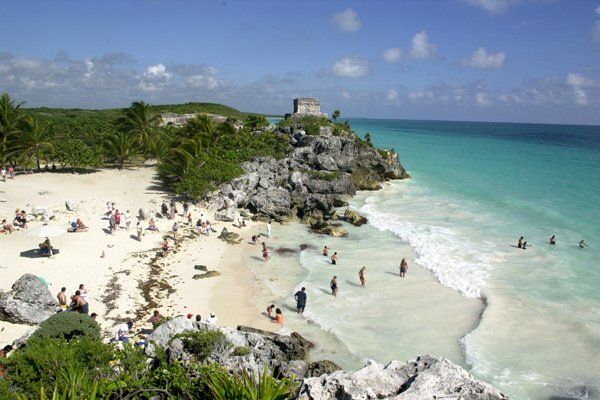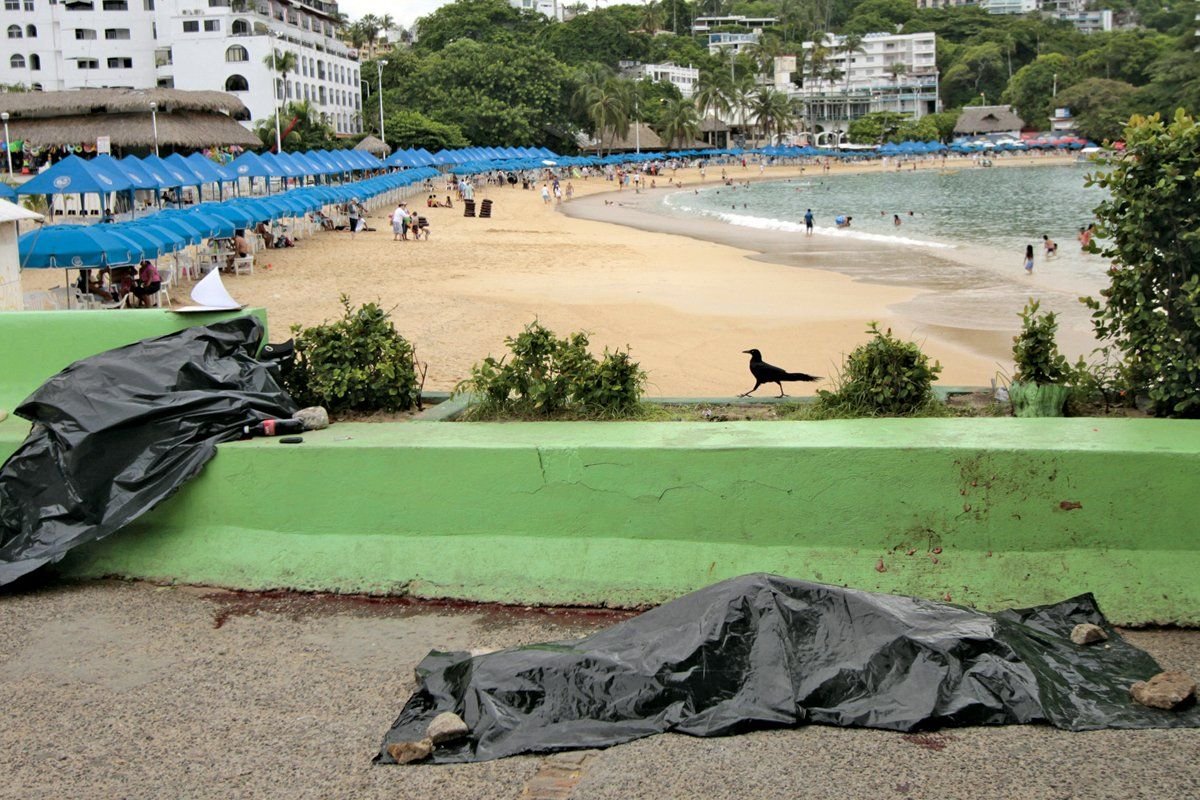
One warm, sunny spring day, I check into Los Flamingos, a pink stucco hotel that sprawls across a cliffside in Acapulco. Los Flamingos was once the cerveza-soaked playground of John Wayne, Cary Grant, and Johnny Weissmuller (a.k.a. Tarzan), who kept a roundhouse on the premises. I try to retrace their gringo wanderings. I sip coffee on the hotel's veranda. I paddle around the pool. I venture out to Señor Johnny's roundhouse. I see smiling, white-uniformed staff members everywhere. But I begin to worry when, two days later, I haven't seen another customer.
"Sunny Acapulco" these days is more like empty Acapulco, a deserted paradise—except for the Army troops. While I sit in the yacht club one morning with a local attorney, we see a federale casually walk through the manicured grounds with a machine gun. Camouflaged troops in black masks whiz up and down La Costera, the city's beachfront drive. What happened? First, the narcos started a death match over Acapulco. Then, the city became a scene in the bloody grindhouse movie playing in American media. "Fifteen Headless Bodies Found in Acapulco," CNN blared earlier this year. "Bag of Severed Heads Left Near Mexican School," another headline announced this month. When I meet an Acapulco official, she says darkly, "We're still alive, no?"
A few days later, I meet Gloria Guevara, Mexico's tourism secretary, in her office in Mexico City. The country's intelligentsia tends to talk about the drug war in terms of overt problems: its duration (four and a half years), body count (35,000 dead), and collateral damage (civil-rights abuses, uneven prosecutions, you name it). Guevara talks about it as a PR problem. Like BP and Goldman Sachs, the Mexican brand has become toxic. "Many, many years ago, we Mexicans didn't take the time to decide the image or the branding of Mexico," Guevara says. "It was decided by someone else." Guevara is trying to rebrand Mexico.
Guevara has eyelashes like the teeth of a Venus flytrap and wears sweeping, brightly colored dresses. She has commanded her staff to call her on her BlackBerry whenever Mexico gets "bad news." In April, 183 bodies were found 85 miles south of the American border in the state of Tamaulipas. The massacre posed little danger to tourists (Tamaulipas will never be mistaken for Cancún), but the words "mass grave" rolling along the CNN crawl is the kind of thing a turista doesn't forget. Guevara's phone buzzed.
More bad news: before Texas Gov. Rick Perry launched his presidential campaign, his state government urged citizens to "avoid traveling to Mexico"—the whole country, from Ciudad Juárez to Cozumel. In April, the State Department issued a jittery travel warning that cataloged death and murder in 14 of the 31 Mexican states. It was like "40 percent of our country was up in flames," grumbles Rodolfo López Negrete, chief operating officer of the Mexico Tourism Board.
In the face of death screams from the north, Guevara is gamely changing the subject: what does a severed head in Juárez have to do with the mole negro in Oaxaca? Her rebranding campaign has a defiant air. Even though 2010 was the drug war's bloodiest year, with more than 15,000 dead, Mexico's president, Felipe Calderón, declared 2011 the "year of tourism." Guevara bought ads in America with the winking tagline "Mexico, the Place You Thought You Knew." Visions of scuba divers and old churches—rather than bodies hanging from overpasses—adorned posters in the New York subway.
Mexico's PR war is a campaign of warm smiles—tortillas, not bombs. "I think there's an untold side of the story," Guevara says. Her attempt to reprogram the turista says a lot about what America thinks of its neighbor. It also says a lot about what Mexico thinks of itself.
Gloria Guevara, who was born in 1967, has always noted how Mexico was seen through gringo eyes. Her father, the Mexican Army general Gustavo Guevara, liked to take the family on Clark Griswold road trips across America: to Houston, Detroit, Niagara Falls. Guevara was in college when an 8.1 earthquake tore through Mexico City in 1985. Her predecessors at the tourism department raced in front of CNN cameras to tell the world that the affected area was only about the size of Central Park. It was an early lesson for Guevara in the geography of disaster.
Guevara was a fast riser in the Mexico office of Sabre, the American travel-technology company that owns Travelocity. She tailored Mexico's sales pitch to America's wants. "Gloria has done a really good job of being able to begin to describe Mexico in experiential terms," says Greg Webb, president of the Sabre Travel Network. Last January, Calderón summoned Guevara to his office and decided she could perform a similar miracle for the government. Referring to Sabre, Calderón asked her, "How much time do you need to talk to the gringos?"
Becoming Mexico's tourism secretary in 2010 was a dubious honor, like becoming Solyndra's governmental affairs liaison this fall. Besides the drug war, Mexico in 2009 was battered by two events: the H1N1 pandemic, which scared off the cruise ships, and the Great Recession, which scared off just about everybody else. "It was the worst year for Mexican tourism ever," says Teresa Solís, a consultant and former official at the Mexico Tourism Board. The number of foreign tourists in Mexico plunged from 22.6 million in 2008 to 21.5 million in 2009. The country lost $2 billion in revenue. The number of tourists has since returned to 2008 levels, but Mexico still hasn't recovered the lost revenue.

Guevara's idea, she tells me, is to replace the bloodstained image of Mexico with an exotic one. Last fall, the Mexico Tourism Board rented a billboard in Times Square. It featured destinations like the Cave of Swallows, a 1,000-foot-deep chasm in San Luis Potosí into which a visitor can rappel down on a rope or plunge into with a parachute. Guevara has moved away from the traditional focus on "sun and beach" getaways and toward a European vision of colonial villages and gastronomy. It's reminiscent of the 1940s, when Mexico City, trying to lure Americans after the Mexican Revolution, was marketed as the "Paris of the New World."
Mexico wants to be glamorous again. In April, the government brought Jennifer Lopez to Chichén Itzá and paid for her stay in the Mayaland resort. Lopez wound up filming a music video at the ruins. "Heading to the hardcore streets of Mexico," Sylvester Stallone tweeted last November, before meeting Guevara in Rosarito, a seaside town 20 miles south of the California border. Stallone was there to scout locations for an Expendables sequel, but he wound up happily chomping down lobster tacos. "We just learned the Housewives of Beverly Hills are coming to Guadalajara," Rodolfo López Negrete says proudly.
Guevara's prized PR agent is Calderón, the man who launched the drug war and led Mexico down the dark path of violence. (Guevara showed me his alias in her BlackBerry chat feature, which she'd marked jefe—the boss.) In February, Calderón effectively stopped work and took Peter Greenberg, TV's Travel Detective, on a five-day tour of Mexico for a special that aired in September on PBS. Calderón strapped on scuba gear and rappelled into the Cave of Swallows. He posed atop the Pyramid of the Sun at Teotihuacán in indigenous dress. ("He is a man who has climbed to the top," the narration intoned, as if an Indian emperor had returned.) It was an act of defiant sightseeing, like George W. Bush returning to New Orleans to buy gumbo and a Hurricane.
Whether Americans are moved by this outpouring is another matter. The U.S.-Mexico border is also a media border: how Mexico is portrayed in the American press is how it's portrayed to the world. "We have almost universal health care," one Mexican official tells me, "but why is it that not even Mexicans know about it? Because we're losing the battle of the airwaves." Severed heads have become the singular story of Mexico, drowning out even the country's surprisingly robust growth during the Great Recession. "Everything you do is like the fourth paragraph," the official says. "It should be the headline."
One reason Americans fear Mexico is that they genuinely misunderstand its danger. Each new atrocity produces reams of copy. But if you look at the number of Americans killed in Mexico since the drug war began in 2006, and then isolate the number of innocents "caught in the crossfire," it amounts to only 10 or 20 killings per year, according to research compiled by the University of San Diego's Trans-Border Institute. This is in a country with hundreds of thousands of American expats and more than 17 million American tourists. "It would be naive to say there is zero risk," says David Shirk, the Trans-Border Institute's director. "But it would be alarmist to say the risk is much higher than 'very low.'?"
Another reason Americans fear Mexico is the Mexi-terror peddled by politicians. In Texas, a group of Republicans have kicked off a new border war. "You know those police warning tapes?" Greg Abbott, Texas's attorney general, tells me this spring. "It's like we have a warning tape stretched across our border." Traveling to Mexico, Abbott adds, is "taking your life into your own hands."
Ted Poe, a U.S. congressman from the Houston suburbs, says flatly, "I wouldn't go to Mexico." A few months before he declares he is running for president, Rick Perry tells me, "Being the governor of Texas and having the high profile I do, I don't want my children traveling in Mexico." As for Texas's sweeping travel warning, Perry added, "That's going to continue to stay in place as long we see the violence emanating out of the country."
López Negrete quips, "We know Padre Island had a banner year in tourism."
But this is the drug war's effect on America's brain. "Mexico" has become a single, undifferentiated narcosphere. Part of what makes Guevara's rebranding effort so tricky is that she lacks a geographic metaphor to explain where the violence is. It rages mostly along the border, but it has also popped up in colonial cities like Morelia, in business hubs like Monterrey, and in resort towns like Mazatlán and Acapulco.

One afternoon in the spring, I meet Alejandro Poiré, a short, stocky man who is Mexico's federal security spokesman. Poiré, who was educated at Harvard, is an apparatchik with a snide, cutting style—a Mexican Ari Fleischer. To the Texans' concerns about spillover violence, Poiré quips, "The most significant concern in terms of 'spillover' is the spillover of the guns that are coming from the southern border of the United States into Mexico." He quickly adds, "You can quote me on that."
I ask Poiré about the problem of metaphor. He thinks for a moment and then ventures one. Imagine Mexico is a beautiful, sun-drenched house, Poiré says. One day, the owner of the house discovers a rat. The rat in Poiré's metaphor is a narco. This isn't the kind of metaphor I had in mind, but I let Poiré keep talking. He says that the owner of the house neglects the rats, and they become two, then three, then four. Soon, the rats—that is, the narcos—are crawling out of every nook and cranny, and it's time to call the exterminator. "President Calderón," Poiré says, "realized that the basement was loaded with rats."
Acapulco is safe, Guevara tells me. You won't notice the rats. The U.S. State Department, meanwhile, warns of "daylight gunfights" and the "deaths of innocent bystanders." Rick Perry doesn't think I should go there at all.
As I wander past the gleaming hotels, I think about the problem of defining "safe." The day before I arrive, someone apparently attacks a city building, a few miles from Los Flamingos, in a bid to murder the city's traffic chief. But nobody attacks me. I hop into one of the blue-and-white Volkswagen Beetle cabs that death-race along La Costera. Late at night, I eat molcajete acapulque–o, sizzling piles of steak and pork and grilled cactus, in largely empty restaurants. I never once feel the clammy hand of the narcos. My great tragedy is that I leave my iPhone in a cab.
To read the American press, you'd never know Acapulco is also a municipio—a county. When a news story reports someone is murdered in "Acapulco," it often means they're killed in distant communities on the other side of the Sierra Madre like Las Cruces and Renacimiento. But the story trundles across the international wires anyway, conjuring the image of Captain Stubing getting beheaded as he steps off the Love Boat. A geographical imprecision slimes the whole city. Acapulco is Mexico in miniature.
By the time the summer ended, street gangs had once again upped the murder rate in Acapulco and killed off the nightlife. This is what haunts Mexico: genuine violence, on the one hand, but also its aftershocks—a PTSD in the gringo imagination. America has never had a real debate over the Mexican drug war, and two presidents' enthusiastic backing of it, so instead we worry whether it's safe to go to the beach. Octavio González Flores, the director of Acapulco's port authority, says the number of foreign cruise ships will fall this year from 90 to about 40. In an ironic twist, Sunny Acapulco has become an almost fully Mexican destination. John Wayne and Johnny Weissmuller's paradise has been reconquered by chilangos from the capitol in search of cheap hotel rooms.
Back at the Los Flamingos bar one night, I sip a coco loco—a house specialty involving tequila, rum, and an unripe coconut—and I think of Guevara's most plaintive sales pitch. The adventurous gringo who goes to Mexico now, scaling his own psychic border wall, is rewarded by rock-bottom prices. I tell the manager of Los Flamingos I'm thinking about staying an extra day or two in Acapulco. "Se–or," he says wearily, "you can stay as long as you want."
Uncommon Knowledge
Newsweek is committed to challenging conventional wisdom and finding connections in the search for common ground.
Newsweek is committed to challenging conventional wisdom and finding connections in the search for common ground.
About the writer
To read how Newsweek uses AI as a newsroom tool, Click here.








